
Concept explainers
a)
To solve: The given information by using the assignment method.
Introduction: The assignment method is one of the methods available in the process of optimization. Here, the jobs are assigned to every available resource.
a)
Answer to Problem 7P
The problem has been solved by using the assignment method.
Explanation of Solution
Given information:
| Squad | Case | ||||
| A | B | C | D | E | |
| 1 | 14 | 7 | 3 | 7 | 27 |
| 2 | 20 | 7 | 12 | 6 | 30 |
| 3 | 10 | 3 | 4 | 5 | 21 |
| 4 | 8 | 12 | 7 | 12 | 21 |
| 5 | 13 | 25 | 24 | 26 | 8 |
Assign cases to respective squads:
Row minimum:
| Squad | Case | Row minimum | ||||
| A | B | C | D | E | ||
| 1 | 14 | 7 | 3 | 7 | 27 | 3 |
| 2 | 20 | 7 | 12 | 6 | 30 | 6 |
| 3 | 10 | 3 | 4 | 5 | 21 | 3 |
| 4 | 8 | 12 | 7 | 12 | 21 | 7 |
| 5 | 13 | 25 | 24 | 26 | 8 | 8 |
Table after the row subtraction is given below:
The row minimum value mentioned in the above table should be subtracted from each value of the row.
| Squad | Case | ||||
| A | B | C | D | E | |
| 1 | 11 | 4 | 0 | 4 | 24 |
| 2 | 14 | 1 | 6 | 0 | 24 |
| 3 | 7 | 0 | 1 | 2 | 18 |
| 4 | 1 | 5 | 0 | 5 | 14 |
| 5 | 5 | 17 | 16 | 18 | 0 |
Column minimum:
| Squad | Case | ||||
| A | B | C | D | E | |
| 1 | 11 | 4 | 0 | 4 | 24 |
| 2 | 14 | 1 | 6 | 0 | 24 |
| 3 | 7 | 0 | 1 | 2 | 18 |
| 4 | 1 | 5 | 0 | 5 | 14 |
| 5 | 5 | 17 | 16 | 18 | 0 |
| Column minimum | 1 | 0 | 0 | 0 | 0 |
Table after the column subtraction is given below:
The column minimum value mentioned in the above table should be subtracted from each value of the column.
| Squad | Case | ||||
| A | B | C | D | E | |
| 1 | 10 | 4 | 0 | 4 | 24 |
| 2 | 13 | 1 | 6 | 0 | 24 |
| 3 | 6 | 0 | 1 | 2 | 18 |
| 4 | 0 | 5 | 0 | 5 | 14 |
| 5 | 4 | 17 | 16 | 18 | 0 |
Assigning squads to the cases:
Step 1: The first row must be checked for the zero. As there is only one zero in the first row, it must be marked and the entire column should be striked out.
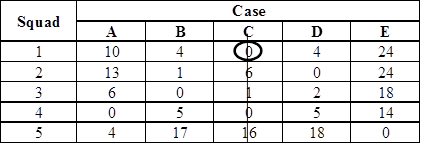
Step 2: As only one zero is available in the second row, it must be marked and the entire column should be striked out.
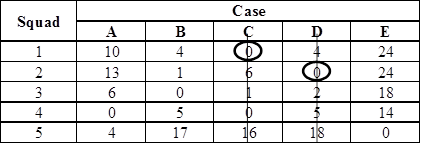
Step 3: As only one zero is available in the third row, it must be marked and the entire column should be striked out.
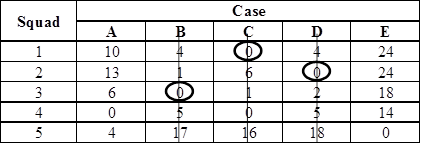
Step 4: As only one zero is available in the fourth row, it must be marked and the entire column should be striked out.
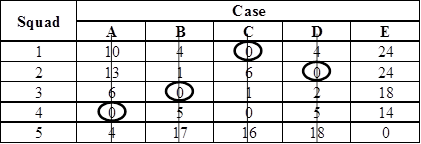
Step 5: As only one zero is available in the fourth row, it must be marked and the entire column should be striked out.
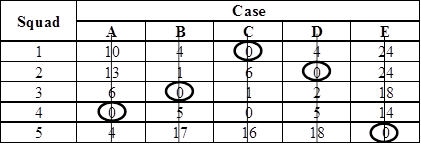
Step 5: All the zeroes in the table have been striked out. The marked zeroes help to assign the cases to the squads.
Calculate the total person-days that are projected by using the assignment method:
The value has been taken in the given information where, the zeroes have been marked in the final answer.
| Squad | Case | Value |
| 1 | C | 3 |
| 2 | D | 6 |
| 3 | B | 3 |
| 4 | A | 8 |
| 5 | E | 8 |
| Total | 28 | |
According to the table, Squad 1 should be assigned to Case C, Squad 2 should be assigned to Case D, Squad 3 should be assigned to Case B, Squad 4 should be assigned to Case A, and Squad 5 should be assigned to Case E. The total person days are 28 days.
b)
To solve: The given information by using assignment method.
Introduction: The assignment method is one of the methods available in the process of optimization. Here, the jobs are assigned to every available resource.
b)
Answer to Problem 7P
The problem has been solved by using the assignment method.
Explanation of Solution
Given information:
| Squad | Case | ||||
| A | B | C | D | E | |
| 1 | 14 | 7 | 3 | 7 | 27 |
| 2 | 20 | 7 | 12 | 6 | 30 |
| 3 | 10 | 3 | 4 | 5 | 21 |
| 4 | 8 | 12 | 7 | 12 | 21 |
| 5 | 13 | 25 | 24 | 26 | 8 |
It is given that the squad 5 cannot work on Case 5 because of the conflict.
Modified given information:
It is given that the squad 5 cannot work on Case 5 because of the conflict. Thus, the value should be modified from 8 to any other higher values. It is taken as 50 here.
| Squad | Case | ||||
| A | B | C | D | E | |
| 1 | 14 | 7 | 3 | 7 | 27 |
| 2 | 20 | 7 | 12 | 6 | 30 |
| 3 | 10 | 3 | 4 | 5 | 21 |
| 4 | 8 | 12 | 7 | 12 | 21 |
| 5 | 13 | 25 | 24 | 26 | 50 |
Assign cases to respective squads:
Row minimum:
| Squad | Case | Row minimum | ||||
| A | B | C | D | E | ||
| 1 | 14 | 7 | 3 | 7 | 27 | 3 |
| 2 | 20 | 7 | 12 | 6 | 30 | 6 |
| 3 | 10 | 3 | 4 | 5 | 21 | 3 |
| 4 | 8 | 12 | 7 | 12 | 21 | 7 |
| 5 | 13 | 25 | 24 | 26 | 50 | 13 |
Table after the row subtraction is given below:
The row minimum value mentioned in the above table should be subtracted from each value of the row.
| Squad | Case | ||||
| A | B | C | D | E | |
| 1 | 11 | 4 | 0 | 4 | 24 |
| 2 | 14 | 1 | 6 | 0 | 24 |
| 3 | 7 | 0 | 1 | 2 | 18 |
| 4 | 1 | 5 | 0 | 5 | 14 |
| 5 | 0 | 12 | 11 | 13 | 37 |
Column minimum:
| Squad | Case | ||||
| A | B | C | D | E | |
| 1 | 11 | 4 | 0 | 4 | 24 |
| 2 | 14 | 1 | 6 | 0 | 24 |
| 3 | 7 | 0 | 1 | 2 | 18 |
| 4 | 1 | 5 | 0 | 5 | 14 |
| 5 | 0 | 12 | 11 | 13 | 37 |
| Column minimum | 0 | 0 | 0 | 0 | 14 |
Table after the column subtraction is given below:
The column minimum value mentioned in the above table should be subtracted from each value of the column.
| Squad | Case | ||||
| A | B | C | D | E | |
| 1 | 11 | 4 | 0 | 4 | 10 |
| 2 | 14 | 1 | 6 | 0 | 10 |
| 3 | 7 | 0 | 1 | 2 | 4 |
| 4 | 1 | 5 | 0 | 5 | 0 |
| 5 | 0 | 12 | 11 | 13 | 23 |
Assigning squads to the cases:
Step 1: The first row must be checked for the zero. As there is only one zero in the first row, it must be marked and the entire column should be striked out.
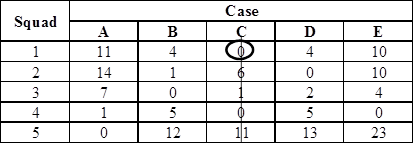
Step 2: As only one zero is available in the second row, it must be marked, and the entire column should be striked out.
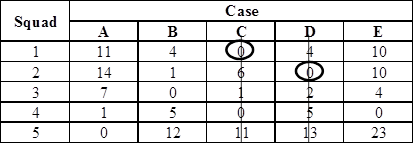
Step 3: As only one zero is available in the third row, it must be marked, and the entire column should be striked out.

Step 4: As only one zero is available in the fourth row, it must be marked, and the entire column should be striked out.
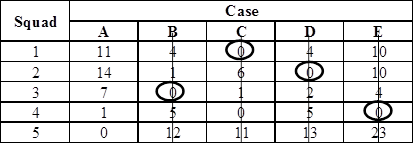
Step 5: As only one zero is available in the fifth row, it must be marked, and the entire column should be striked out.
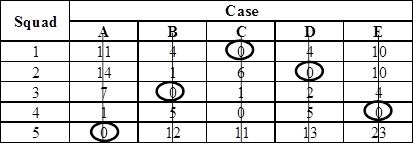
Step 5: All the zeroes in the table have been strikedout. The marked zeroes help to assign the cases to the squads.
Calculate the total person days that are projected by using the assignment method:
The value has been taken in the given information where, the zeroes have been marked in the final answer.
| Squad | Case | Value |
| 1 | C | 3 |
| 2 | D | 6 |
| 3 | B | 3 |
| 4 | E | 21 |
| 5 | A | 13 |
| Total | 46 | |
According to the table, Squad 1should be assigned to Case C, Squad 2 should be assigned to Case D, Squad 3 should be assigned to Case B, Squad 4 should be assigned to Case E, and Squad 5 should be assigned to Case A. The total person days are 46 days.
Want to see more full solutions like this?
Chapter 15 Solutions
EBK PRINCIPLES OF OPERATIONS MANAGEMENT
- Do you feel there is anything positive about rework?arrow_forwardDo you think technology can achieve faster setup times? How would it be implemented in the hospital workforce?arrow_forwardIn your experience or opinion, do you think process changes like organizing workspaces make a bigger difference, or is investing in technology usually the better solution for faster setups?arrow_forward
- Have you seen rework done in your business, and what was done to prevent that from occurring again?arrow_forwardResearch a company different than case studies examined and search the internet and find an example of a business that had to rework a process. How was the organization affected to rework a process in order to restore a good flow unit? Did rework hurt a process or improve the organization's operational efficiency? • Note: Include a reference with supportive citations in the discussion reply in your post.arrow_forwardSetup time is very important in affecting a process and the capacity of a process. How do you reduce setup time? Give examples of reducing setup time. Please Provide a referenecearrow_forward
- Do you think TPS was successful? If so, how? Are there other companies that have used TPS? If so, give examples. Please provide a referencearrow_forwardGiven the significant impact on finances, production timelines, and even equipment functionality, as you pointed out, what do you believe is the most effective single strategy a company can implement to significantly reduce the occurrence of rework within their operations?arrow_forwardDurban woman, Nombulelo Mkumla, took to social media last week to share how she discovered the rodent.In a lengthy Facebook post, she said she purchased the loaf of bread from a local shop after work on August 27.For the next days, Mkumla proceeded to use slices of bread from the load to make toast."Then, on the morning of August 31, I took the bread out of the fridge to make toast and noticed something disgusting andscary. I took a picture and sent it to my friends, and one of them said, 'Yi mpuku leyo tshomi' [That's a rat friend]“."I was in denial and suggested it might be something else, but the rat scenario made sense - it's possible the rat got into thebread at the factory, and no one noticed," Mkumla said.She went back to the shop she'd bought the bread from and was told to lay a complaint directly with the supplier.She sent an email with a video and photographs of the bread.Mkumla said she was later contacted by a man from Sasko who apologised for the incident.According to…arrow_forward
- PepsiCo South Africa says the incident where a woman discovered part of a rodent in her loaf of bread, is anisolated occurrence.Durban woman, Nombulelo Mkumla, took to social media last week to share how she discovered the rodent.In a lengthy Facebook post, she said she purchased the loaf of bread from a local shop after work on August 27.For the next days, Mkumla proceeded to use slices of bread from the load to make toast."Then, on the morning of August 31, I took the bread out of the fridge to make toast and noticed something disgusting andscary. I took a picture and sent it to my friends, and one of them said, 'Yi mpuku leyo tshomi' [That's a rat friend]“."I was in denial and suggested it might be something else, but the rat scenario made sense - it's possible the rat got into thebread at the factory, and no one noticed," Mkumla said.She went back to the shop she'd bought the bread from and was told to lay a complaint directly with the supplier.She sent an email with a video and…arrow_forwardDurban woman, Nombulelo Mkumla, took to social media last week to share how she discovered the rodent.In a lengthy Facebook post, she said she purchased the loaf of bread from a local shop after work on August 27.For the next days, Mkumla proceeded to use slices of bread from the load to make toast."Then, on the morning of August 31, I took the bread out of the fridge to make toast and noticed something disgusting andscary. I took a picture and sent it to my friends, and one of them said, 'Yi mpuku leyo tshomi' [That's a rat friend]“."I was in denial and suggested it might be something else, but the rat scenario made sense - it's possible the rat got into thebread at the factory, and no one noticed," Mkumla said.She went back to the shop she'd bought the bread from and was told to lay a complaint directly with the supplier.She sent an email with a video and photographs of the bread.Mkumla said she was later contacted by a man from Sasko who apologised for the incident.According to…arrow_forwardRead the project statement and answer ALL of the questions that follow PROJECT STATEMENT The African Integrated High-Speed Railway Network (AIHSRN). African nations are preparing to invest billions in a significant overhaul of their rail infrastructure as part of an ambitious plan for the continent. One of the key projects underway is the African Integrated High-Speed Railway Network (AIHSRN), which aims to connect Africa's capital cities and major commercial centres with a high-speed railway network to enhance continental trade and competition. This network will span 2,000 km (1,243 miles) and connect 60 cities, including Nairobi, Lagos, Cairo, and Dakar. It will improve access to essential markets, enhance economic cooperation, and encourage regional collaboration. The plan is poised to revolutionise intra-African trade by reducing travel times and lowering transportation costs, making trade between African nations more competitive. The trains will be capable of reaching speeds of up…arrow_forward
 Foundations of Business (MindTap Course List)MarketingISBN:9781337386920Author:William M. Pride, Robert J. Hughes, Jack R. KapoorPublisher:Cengage Learning
Foundations of Business (MindTap Course List)MarketingISBN:9781337386920Author:William M. Pride, Robert J. Hughes, Jack R. KapoorPublisher:Cengage Learning Foundations of Business - Standalone book (MindTa...MarketingISBN:9781285193946Author:William M. Pride, Robert J. Hughes, Jack R. KapoorPublisher:Cengage Learning
Foundations of Business - Standalone book (MindTa...MarketingISBN:9781285193946Author:William M. Pride, Robert J. Hughes, Jack R. KapoorPublisher:Cengage Learning Practical Management ScienceOperations ManagementISBN:9781337406659Author:WINSTON, Wayne L.Publisher:Cengage,
Practical Management ScienceOperations ManagementISBN:9781337406659Author:WINSTON, Wayne L.Publisher:Cengage,


